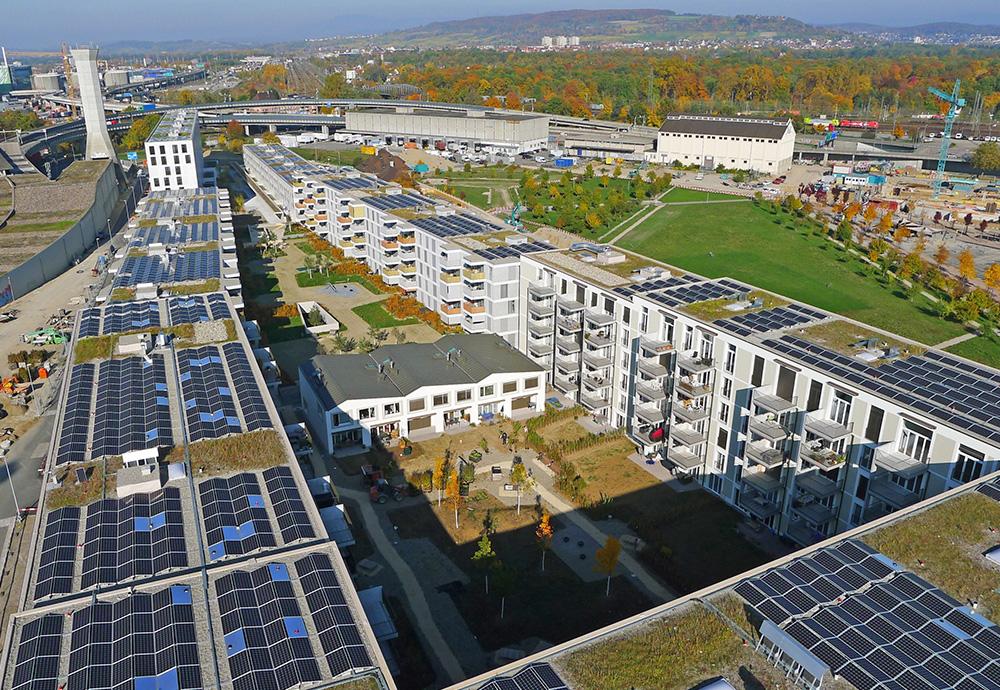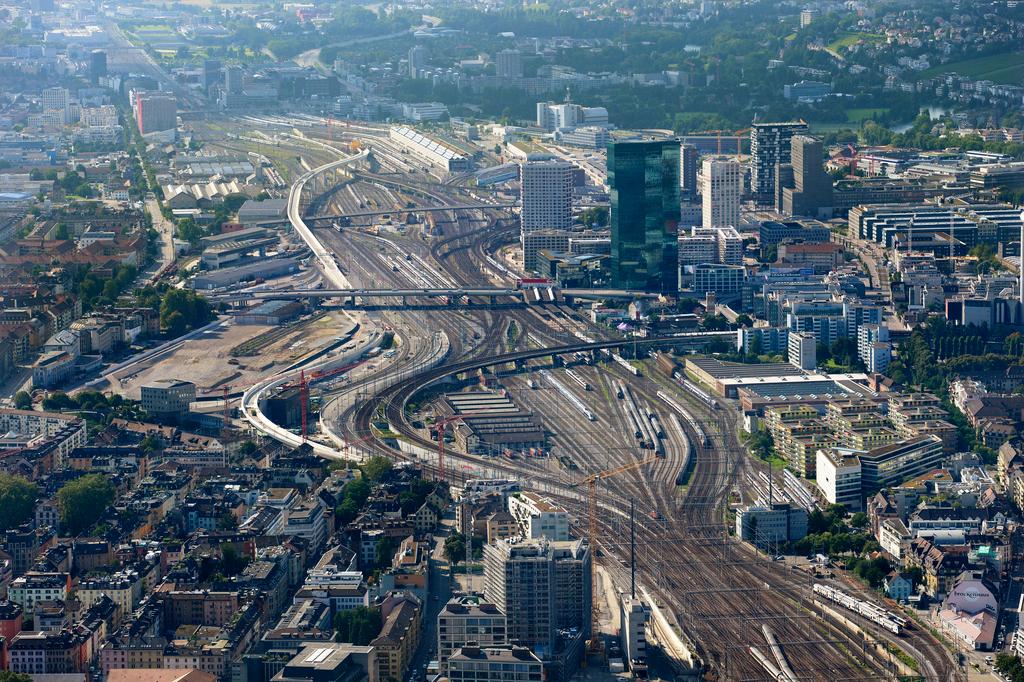2,000-watt society: when the future becomes a reality

Can people halve their energy consumption and still live comfortably? In Switzerland, the first neighbourhoods are being built according to the “2,000-watt society” principle, which aims to conserve resources without compromising living standards.
Situated in an outer suburb of Bern, near a railway line and a motorway, the new Stöckacker Süd housing complex resembles many others under construction in Switzerland. Three large concrete buildings of five to six stories each, with balconies along one side, will contain 146 apartments once the project is completed in 2017. The first tenants will move in by the end of this year.
But this complex is different, because it will be one of the first designed for very low energy consumption under the vision of a society where every person only consumes 2,000 watts of energy per day. That’s expected to become the norm in the coming decades in Switzerland.
The buildings are made of recycled concrete and perfectly insulated, in keeping with the Minergie-P-Eco standard, which provides not only the maximum energy efficiency but also other advantages such as optimal natural lighting, internal spaces free of toxic substances, and a low level of radiation.
The 2000-watt society
The 195 countries that took part in COP 21, the international climate conference held in Paris last December, reached an accord for sustainable use of energy resources, so as to limit the increase in worldwide temperatures to between 1.5 and 2 degrees by 2100 compared to pre-industrial levels. This goal can be reached only if per capita emissions of CO2 do not exceed 1 metric ton a year – or, in terms of the model proposed by researchers at ETH Zurich, if primary energy needs worldwide do not exceed an upper limit of 2,000 watts per person.
2,000 watts corresponds to annual consumption of about 17,500 kilowatt hours of electricity or 1,700 litres of petroleum. Today the world average is around 2,500 watts.
Future residents of Stöckacker Süd will have to accept a few more restrictions to their lifestyle compared with other Swiss. Their living space will not be more than 60 square metres (645 square feet) per person and the building will have just 27 parking spaces, of which 15 will be reserved for disabled users. But its 510 bicycle parking spaces and proximity to public transport also make the development a model for sustainable mobility.
Those terms don’t seem to discourage potential renters in Bern, where half of all households are car-free.“When we presented this project, a lot of people told us we wouldn’t find any tenants. But in the space of a few months…we got more applications than there were apartments available,” says a satisfied Renato Bomio, head of housing projects for the city of Bern.
Equitable distribution of resources
Stöckacker Süd is one of a few housing complexes in Switzerland to be awarded the “2,000-watt area” certificate by the Federal Office of Energy, inspired by a model created by researchers at the federal technology institute ETH Zurich. According to that model, sustainable use and equitable distribution of resources around the world is only possible if every person’s energy use stays below 2,000 watts. That’s about how much energy the average Swiss consumed in the 1960s.
According to the ETH research group, this goal can be reached essentially without compromising current living standards, thanks to new technical solutions and a series of actions taken to improve energy efficiency.
At the moment, Switzerland is far from this level. Only 2% of the population lives on less than 2,000 watts, while the average per person is over 5,000 watts. This is still a lot less than the US, where per capita energy demand is over 10,000 watts – but far above the African average, which is 500 watts.
While industrialised countries need to reduce their energy consumption, developing countries thus still have a margin of increase before they get to 2000 watts. Above this threshold, says the ETH Zurich model, increased consumption is no longer matched by an improvement in living standards.
The vision of a 2,000-watt society, which is making headway internationally, has become a part of the energy vocabulary of the federal government and most of the cantons. Over 100 municipalities have included this objective in their by-laws or energy strategy. In some places like Zurich, Zug and Aarau, the local population have actually voted in favour of this new kind of energy policy. 2,000-watt areas are one of the main measures being pushed in some municipalities to promote sustainable use of resources and energy.
Advantages for investors
These housing complexes are of interest not only to the public sector: nearly all the initial projects have been carried out by private enterprises.
“The 2,000-watt area certificate provides several advantages for investors,” points out Heinrich Gugerli, project head at the 2000-watt area resource centre set up by the Federal Office of Energy. “Unlike other major building projects, it is easier to get a building permit from local government for such areas. Generally, they are more likely to be supported by the locals when projects like these get put to a popular vote.”
2,000-watt areas
The 2,000-watt area certificate is awarded by the Energy City Association, which was started by the Federal Office of Energy to promote renewable energies and sustainable use of resources in Swiss municipalities. This label identifies neighbourhoods or settlements on at least one hectare of land satisfying specific requirements for sustainability in construction, renovation and management of buildings, as well as mobility. So far, nine complexes in seven cities and towns – Zurich, Basel, Bern, Lucerne, Lenzburg, Kriens and Prilly/Renens – have received the 2000-watt area certificate. Of these, two have been completed and a further three will be at least partially complete this year.
This view is shared by Massimo Guglielmetti of the property management division of the Swiss Federal Railways, who is in charge of developing the Rösslimatt Village, beside the main station in Lucerne.
“The 2,000-watt area certificate brings added value in terms of marketing not just to promote our project in the city, but to attract tenants, given that, among the various criteria that have to be respected in order to get this label, a high-quality living environment is included”, he says.
While the Stöckacker Süd buildings will be equipped with solar panels and heat pumps to provide heating and hot water, the Rösslimatt complex will be served by a nearby pump station that uses thermal energy from the waters of Lake Lucerne. Over a 20-year period, the Federal Railways plan to build a complete neighbourhood occupying four hectares in the heart of town, which will contain not only apartment blocks but offices, shops, restaurants and a hotel. Situated just beside public transport and car-sharing, the future 2,000-watt area will contain only a few parking spaces.
Lifestyle changes
The success of 2,000-watt areas will depend on the willingness of residents to adjust their lifestyles.
“The idea is not that everybody needs to become vegan, give up everything, and be totally compatible with the 2,000-watt society. But it is important to raise the residents’ awareness of opportunities to reduce energy consumption, for example by using appliances that have optimal energy efficiency,” explains Bomio.
“How individuals are going to behave cannot be laid down in a contract. But it may be influenced, say by contributing to the cost of passes for public transport,” says Gugerli. “Clearly, the 2,000 watts are not going to be feasible if someone is right up to the limit in everything, leaves the television on, takes four or five showers a day and that kind of thing. But everyone can afford to have one ‘vice’!”
Translated from Italian by Terence MacNamee

In compliance with the JTI standards
More: SWI swissinfo.ch certified by the Journalism Trust Initiative












You can find an overview of ongoing debates with our journalists here . Please join us!
If you want to start a conversation about a topic raised in this article or want to report factual errors, email us at english@swissinfo.ch.